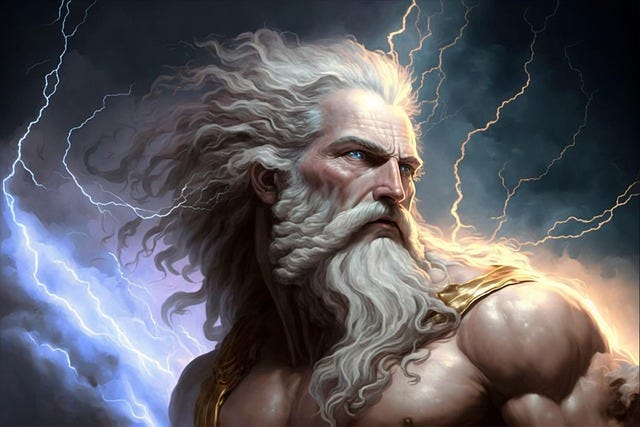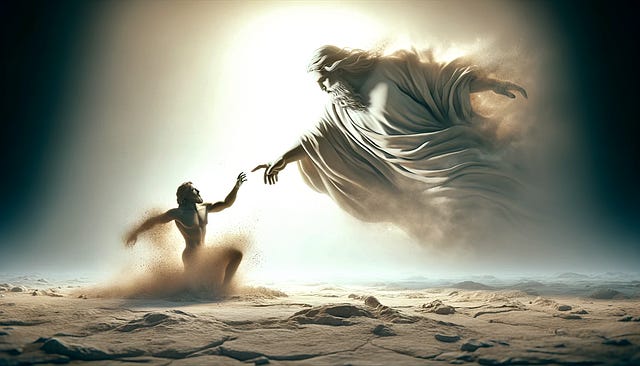Welcome to The Deeper Read—a behind-the-scenes investigation of who wrote the stories that shaped the world. This isn’t your typical study group…or book club. It’s a filmic forensic exploration.
I’m your host, Lisa. And together, we’re digging through ancient drafts, studio notes, and sacred storyboards—reading humanity’s foundational texts the way they were never meant to be read: honestly, curiously, and just a little out of order.
Missed the first assignment? No problem.
We started with Genesis 1–3, where creation gets a double draft, the serpent gets screen time, and Eve might’ve been Bravo’s first fall girl.
You can read that section here: https://biblehub.com/niv/genesis/1.htm
You’re a showrunner. It’s 8:00 a.m. You’re handed the pilot script for a brand-new prestige drama called The Bible. You flip it open, and the opening line is strong:
“In the beginning, God created the heavens and the earth.”
You nod. Cosmic. Expansive. Big budget. It’s giving HBO’s Watchmen.
Listen to the podcast episode here.
But by page two, you’re confused. Wait…didn’t we already see this scene? Wasn’t the world just created? Who are these other characters? Why is God suddenly down in the dirt sculpting clay people like a prop artist on his lunch break?
You flip back. Then forward. Then back again.
“Who wrote this?” you mutter. “And why are there TWO pilots stapled together?”
Welcome to the Genesis writers’ room.
Who’s in the Room?
The first two chapters of Genesis don’t match. That’s not an opinion—that’s a format issue.
Genesis 1 is tight. Structured. Like a modern sci-fi miniseries: six days of creation, then a well-earned seventh-day rest. The protagonist? Elohim—God as cosmic executive producer, calling shots from the director’s chair. Light, water, land, animals, man—boom, boom, boom. It’s giving Stanley Kubrick precision.
But then, Genesis 2 rolls around. Different tone. Different style. Suddenly we’re in a handheld indie film. God—now Yahweh—is getting his hands dirty, shaping a man out of dust, breathing life into his lungs. He’s wandering around a garden, muttering about loneliness. It’s weirdly charming. Intimate. And totally inconsistent.
In the industry, we’d say someone else took a crack at the script.
Some scholars even agree. They call it the Documentary Hypothesis—the idea that multiple writers (nicknamed J, E, P, D) contributed to the Torah over time, stitching together different regional stories and traditions into a single “final cut.”
Meanwhile, a brief but meaningful note on set design…
Living Under the Dome
Genesis describes a hammered-out “dome” (or firmament) that separates the waters above from the waters below. That’s not just poetic—it’s ancient cosmic architecture.
Don’t worry—we’ll revisit it when Noah gets a weather upgrade.
So, yeah. If this was a writers’ room, it had drama. Honestly, it feels less like a polished series and more like a reality mockumentary hybrid—heavily scripted, constantly re-edited, and forever on the verge of a cast shake-up.
That format exploded in the early aughts—and honestly? People still keep trying to make it work.
Let Us Make Man (Cut to Confessional Cam)
Suddenly, in Genesis 1:26, the tone shifts again. And not in a good way. It’s like a mic picked up a stage whisper we weren’t supposed to hear:
“Let us make man in our image.”
Hold up. Us? Who’s “us”?
Smash cut to a mockumentary-style confessional interview, straight out of The Office:
GOD:
“I didn’t mean to say ‘us.’ That was...uh...production language. Royal ‘we.’ You know. Editorial.”PRODUCER:
(offscreen)
“But…you’re supposed to be the only one here.”GOD:
“Look, just circle back with my publicist for talking points.”
This is the moment in the script where the mythology starts breaking the fourth wall. Are we dealing with one god or many? Angels? A divine entourage? Or just a continuity error nobody caught in post? Rookie mistake.
It doesn’t really matter. Because the story’s already rolling. The set’s been built. And the camera’s pushing in on our main character—an unnamed man made from dirt.
The Serpent’s Pep Talk
Enter the serpent. Not slithering through grass—but parked in a Bravo trailer with Andy Cohen, ten minutes before a reunion taping.
“Listen, babe. This is your moment. Don’t play nice. Ask the question. Flip the table. The memes made of that moment will be iconic. That’s how you become television royalty.”
After receiving that speech, the serpent doesn’t lie outright. He just delivers that classic producer request: sow doubt, promise drama, and hint that someone might be holding out on you.
At the end of the day, it’s possible the serpent is just the messenger, passing along a message like so many of our favorite high-profile onscreen villains. Because in this scenario, Andy Cohen isn’t just the host—he’s the devil’s showrunner.
Eve hears it. She bites—literally and figuratively.
Adam follows. Because, let’s be honest, this show’s already been reworked midseason to be all about her. And at this point, he’s just trying to keep his screen time.
And then? The whole show rebrands.
Original working title? “Paradise.”
New working title? “The Fall.”
Cue wardrobe change. They’re hiding in fig leaves. God’s storming around like a network exec who just found out his leads improvised the big scene—and tanked it.
The Eve Edit: Villain or Victim?
So now Eve’s the villain. But is she really?
Or is she being produced into one—scapegoated by a ratings-hungry television exec who promised her eternal youth and a few spinoffs if she stirred the pot?
Was she trying to blow the whistle on something? Or was she just trying to stay in the edit?
Maybe she wasn’t the first sinner. Maybe she was the first industry plant.
Eve: tempted by knowledge—or by fame? Eve: curious rebel—or company girl?
It really is all about Eve, isn’t it?
Did she fall… or was she pushed?
Final Take — A Patchwork Pilot
At the end of the day, these first three chapters don’t read like a divinely dictated screenplay.
They read like the result of a chaotic pitch meeting, multiple showrunners, and too many network notes. There’s brilliance here. But there’s also contradiction, revision, and creative tension. Which, honestly, makes it feel a lot more real.
The Bible doesn’t open with a clean final draft. It opens with a writers’ strike. A pilot in flux. A reality series that’s revealing the script the characters might not even know they’re following. A mystery of authorship that sets the tone for the rest of the series.
And just like any good industry insider, we’re not here to cancel the show. We’re here to read between the lines.
This Week’s Reading Assignment
Genesis 4
Adam and Eve have kids. One becomes the first murderer. The other? Honestly? The script forgets about him.
Why this version?
We’re reading from the NIV (New International Version) because it’s widely accessible, easy to read, and still sticks pretty closely to the original structure and flow. It’s not the most literal translation, but it’s one of the most popular—and a great “industry standard” for getting a general feel before we start breaking it all down.
Further Reading & Receipts
The Documentary Hypothesis & Authorship of Genesis
Who Wrote the Bible? by Richard Elliott Friedman — a foundational, accessible intro to source criticism.
https://www.amazon.com/Who-Wrote-Bible-Richard-Friedman/dp/0060630353Overview of J, E, P, D source theory from Bible Odyssey (Society of Biblical Literature):
https://academic.kellogg.edu/marklinl/Bible/Readings/DocumentaryHypothesis.htm
“Let Us Make Man” — Divine Plurality
Genesis 1:26 Plurality Explained
Scholar-written article: Genesis and the Twilight of the Gods on TheTorah.com:
https://www.thetorah.com/article/genesis-and-the-twilight-of-the-godsChristian Perspective on Divine Council Imagery
Updated link: GotQuestions article “What does it mean when God said, ‘Let Us make man in Our image…’”
https://www.compellingtruth.org/let-us-make-man-in-our-image.html
Eve, The Serpent, Revisionist Takes
A Jewish feminist midrash interpretation of Eve and the Fall:
https://jwa.org/encyclopedia/article/eve-midrash-and-aggadah
Lilith, The (Alleged) First Woman
“Monsters, Demons, and Other Mythical Creatures in Jewish Lore” – MyJewishLearning offers a well-rounded overview of Lilith’s origins as a night-demon and how she later became mythologized as Adam’s first wife.
https://www.myjewishlearning.com/article/monsters-demons-and-other-mythical-creatures-in-jewish-lore/“Lilith” – Jewish Women’s Archive – A concise breakdown of Lilith’s evolution in Hebrew scripture and folklore, including her representation in Isaiah, Talmudic lore, ancient amulets, and her reinvention as a feminist icon.
https://jwa.org/encyclopedia/article/lilith“Lilith: Definition & Mythology” – Britannica – A clear, academic summary of Lilith within Near Eastern mythology, emphasizing her Mesopotamian origins, biblical references, and later folkloric developments
https://www.britannica.com/topic/Lilith-Jewish-folklore
The Firmament
Firmament in Ancient Hebrew Cosmology
Try this Biologos article:
“The Firmament of Genesis 1 is Solid but That’s Not the Point”
https://biologos.org/articles/the-firmament-of-genesis-1-is-solid-but-thats-not-the-pointBible Project explainer video on Ancient Cosmology (short & engaging):
https://bibleproject.com/videos/heaven-and-earth/
Thanks for joining me on The Deeper Read.
If you like where this is going, subscribe to LisaWritesNow on Substack—that’s where you’ll find full transcripts, bonus content, and deeper receipts.
And if you're ready to go further down the rabbit hole...
Season 2 of The Hidden Cut is already in the works, picking up right where this season leaves off.
🎬 Continue the Series
← Previous Episode: Genesis Writers’ Room
→ Next Episode: The Blood Feud
📂 Full Episode Guide: Cold Open
Think something got left on the cutting room floor?
Add your notes below—we’re still editing in real time.







